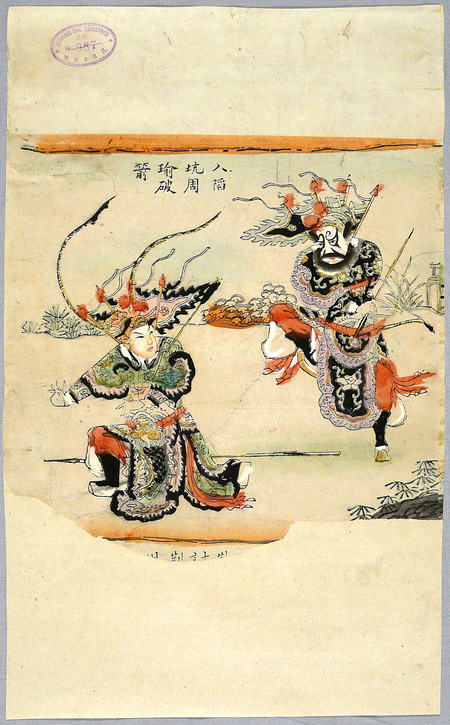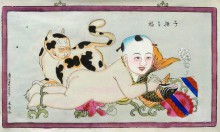The Khanenko Museum has opened the exhibition entitled “Paintings and Graphics of Asia,” which is a part of the program “Ars Longa: Restorers and Restoration.” This long-term project is a joint creative collaboration between Museum of Western and Oriental Art and the National Research and Development Center for Restoration of Ukraine, aimed to show people of Kyiv the huge role Ukrainian restorers play not only in maintaining, but also in restoring the unique collection of world art that belongs to the Khanenko Museum. A well-known Latin phrase “Ars longa, vita brevis” (“Life is short, art is eternal”) suits best to express the meaning and purpose behind the cooperation of the museum staff and the expert restorers, who are able to maintain and present priceless cultural treasures despite the irreversible influence of time. Thus, the first public display of the project presents restored paintings and graphics of Asia.
“Our exhibition features 35 gems of Asian Art, among them – prints of famous Japanese artists Hokusai and Hiroshige, Chinese paintings of the 18th and 19th centuries, and Iranian miniatures of the 17th century,” said Halyna Bilenko, curator of the exhibition. “There are also Chinese New Year folk pictures, Nian Hua, which heralded happiness for the year to come; it was a tradition to burn them every year – so their samples from the 19th century are very rare now. The display showcases an example of the restorers’ surprisingly meticulous work on the Chinese table screen of the 19th century with Taoist deities pictured on it. Another such example is Buddhist thangka pictures – due to peculiarities of the technique, restoring them poses a serious challenge for modern specialists.”

IMAGES OF TWO ACTORS IN MILITARY DRESS ARE ASSOCIATED WITH ROMANCE OF THREE KINGDOMS – A LITERARY MASTERPIECE OF THE 14TH CENTURY, ADAPTED FOR THE BEIJING OPERA (A NEW YEAR’S NIAN HUA PRINT, LATE 19th – EARLY 20th CENTURIES, CHINA, WOODCUT, PAINTED BY HAND)
The art of Katsushika Hokusai (1760-1849), Japanese artist and illustrator, master of ukiyo-e, will be of much interest to the visitors. He was one of the most famous artists of pre-modern Japanese art.
During his life Hokusai had at least thirty aliases. In 1814 Hokusai created the first series of works under the name of Manga. After that, the name is used to refer to Japanese comics.
In the West, Hokusai is especially famous for his painting The Great Wave off Kanagawa. And Manga (“Hokusai’s funny sketches”) is one of his major works, which he created in the peak of his artistic career. Manga is large and complex, being extremely rich in material. Manga reflects the artist’s point of view on work, on philosophy, it reveals the secrets of skill. Manga is valuable not only as a landmark in Hokusai’s life, but also as a source of information about the culture and art of the late feudal Japan. Hokusai’s Manga is often called the encyclopedia of the Japanese people.

GEISHA, ACCOMPANIED BY THREE SERVANTS. COLOR WOODCUT BY TORII KIYONAGA (1752-1815), JAPAN
Hokusai, like Japanese art in general, made a significant impact on European art of the 19th century, in particular on Art Nouveau (Jugendstil) and French impressionism. Jugendstil’s characteristic intense and convoluted lines, which critics call Peitschenhieb (German for “whiplash”) bear the obvious influence of Hokusai’s motives. Subjects of Hokusai’s prints are present in the works of Claude Monet and Pierre Auguste Renoir.
The audience will also be impressed by the works of Ando Hiroshige (1797-1858), Japanese graphical artist (he is also known by his artistic name Utagawa Hiroshige) and also a master of ukiyo-e. His creations include numerous landscape series of colored woodcuts: “Ten Famous Places in the Eastern Capital” (Tokyo), 1827; “The Fifty-Three Stations of the Tokaido,” 1833-34; “Famous Views of the Sixty-Odd Provinces,” 1853-56; “Thirty-Six Views of Mount Fuji,” 1854-58; “One Hundred Famous Views of Edo,” 1856-58, and others. To produce a skillful rendition of the landscape, he often portrayed the most important, prominent part in the foreground, gently treating the objects in the distance; he also utilized linear perspective. Hiroshige’s landscapes are known for the exquisite lyricism of imagery, and they usually include people who go about their daily business. The works of this master of Japanese painting had greatly influenced European landscape art in the period of impressionism and post-impressionism.
The exhibition will be open till December 25.







